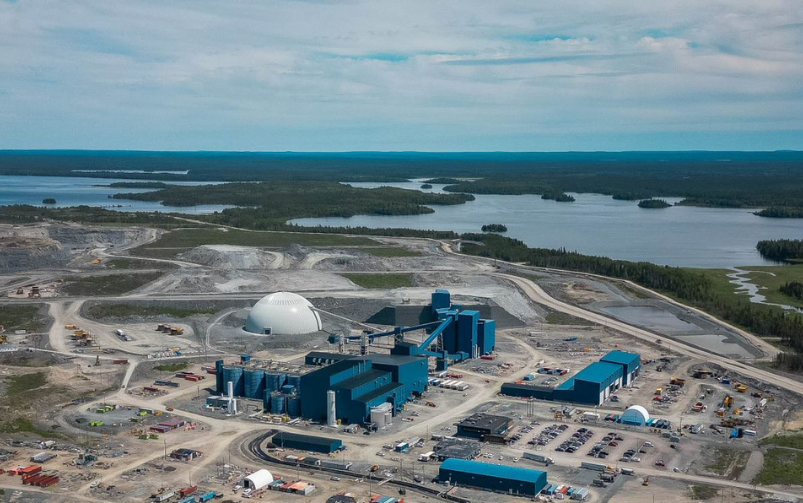(Left to right) Session moderator Robin Stickley, with panelists Christy Smith-Hadath, Carolyn Chisholm, Mark Patterson and Michael Goehring. Photo: Jon Benjamin Photography.
CIM Connect’s General Panel Session on May 14 zoned in on the strength of partnerships in the mining industry and where more work still needs to be done, particularly with Indigenous communities and with educational institutions. Moderator and renowned journalist Robin Stickley welcomed to the stage Carolyn Chisholm, general manager of external affairs at Rio Tinto, Christy Smith-Hadath, vice president, Indigenous and stakeholder engagement at Falkirk, Mark Patterson, B.C. mining leader for PwC Canada, and Michael Goehring, president and chief executive officer of the Mining Association of B.C. (MABC).
An icebreaker question was posed by Stickley to the four panelists on what keeps them awake at night when it comes to meeting societal expectations for the energy transition. Chisholm’s response centred on the environment and the increased demand for copper over the next 25 years in order to support the energy transition. Similar to Chisholm’s response, Goehring focused on Canada’s imperative to meet the increased demand for critical minerals.
Patterson touched on some environmental concerns, including the frequency and severity of Canada’s wildfires each summer. Smith-Hadath, who co-wrote a book focused on advancing economic reconciliation in the resource sector, shared that a lack of Indigenous consent in the mining industry worries her, noting that “we have to integrate Indigenous knowledge into [mining], and that takes time.” Reiterating Freda Campbell’s point made during the May 13 opening plenary session, Smith-Hadath drew attention to the fact that forging genuine partnerships with Indigenous communities should not be rushed.
Goehring later emphasized the importance of Smith-Hadath's view, explaining that advancing economic reconciliation “takes time and commitment.” He added that the industry needs to have a two-way dialogue focused on trust.
Smith-Hadath agreed that this element of trust is crucial but emphasized that companies and those working in the industry should not be so preoccupied with forming these relationships based on a schedule: “It’s unfair, because at the end of the day, the relationship should be ... organic.”
When considering how companies can balance timelines while also building meaningful partnerships with Indigenous nations, Smith-Hadath explained that these relationships should not be treated as “transactional” but that a focus should be placed on ensuring that shared interests are met.
Smith-Hadath also added that there are some “amazing examples across Canada where [Indigenous] nations have really developed partnerships” that are advancing, leading to jobs and other opportunities for local talent in the industry. With that being said, she noted that there is still a stigma surrounding the industry. She recalled her own experience when she first entered the industry 25 years ago and how members of her community maintained a “really strong aversion” to mining. She explained that, even today, despite being qualified to work in mining, some Indigenous people are nervous to enter the industry due to negative perceptions of mining.
In order to improve these perceptions, she encouraged people to share positive and “organic” stories of how Indigenous nations are participating in partnerships. Some of the success stories that she would like to see shared include those from people who work in the mining industry and may struggle with substance abuse or mental illness, and how these individuals received support in the workplace. “I think those are some of the success stories that we need to share, and I don’t think we’re doing a great job yet,” she said.
When the discussion shifted to workforce issues and attracting new workers in mining, Patterson explained that many people do not understand the scope of the industry, specifically in B.C., adding that “there are so many [demographic] groups that we're not tapping into.” He also emphasized that it’s crucial to draw attention to the benefits of a career in mining when seeking to attract fresh talent. He said that more conversations on these benefits need to take place at the high school level and to make students aware of the travel and leadership opportunities that exist in the mining industry.
Smith-Hadath emphasized Patterson’s point, noting that “we have to find better ways to tell our story. We have to find better ways to attract kids to the industry, but we can’t do it by ourselves.”
Goehring briefly touched on hopeful results yielded from an MABC supply chain study for 2021 to 2022, which reflected that there is a growing level of business partnerships with the industry’s Indigenous communities, with over 150 Indigenous-affiliated businesses having sold $975 million worth of goods and services to B.C.’s operating mines and smelters.
As the panel session neared its conclusion, the question of what winning the critical minerals race looks like for Canada came up, with Patterson pointing out that although “we’re never going to be the lowest cost producer of critical minerals in the world,” the industry can aim to win the race by focusing on environmental, social and governance credentials.




